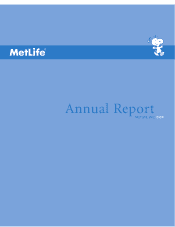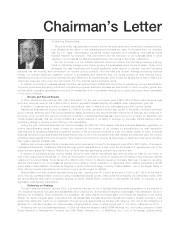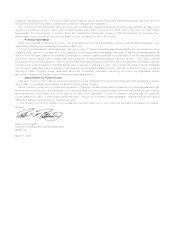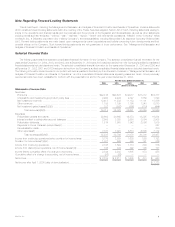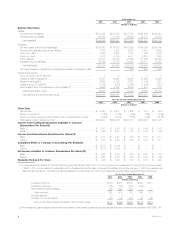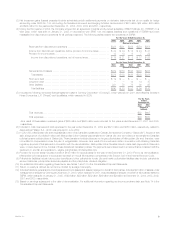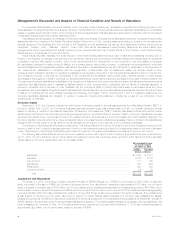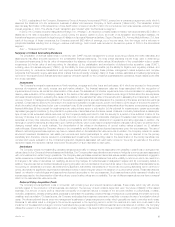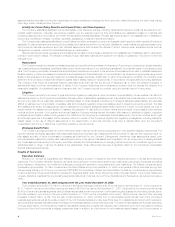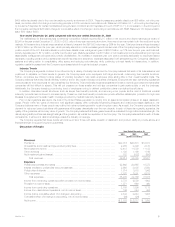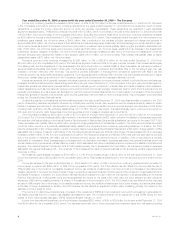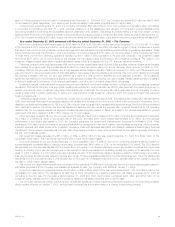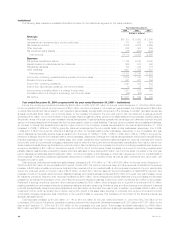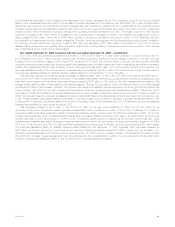MetLife 2004 Annual Report Download - page 9
Download and view the complete annual report
Please find page 9 of the 2004 MetLife annual report below. You can navigate through the pages in the report by either clicking on the pages listed below, or by using the keyword search tool below to find specific information within the annual report.assumes that the expectation for long-term appreciation in equity markets is not changed by minor short-term market fluctuations, but that it does change
when large interim deviations have occurred.
Liability for Future Policy Benefits and Unpaid Claims and Claim Expenses
The Company establishes liabilities for amounts payable under insurance policies, including traditional life insurance, traditional annuities and non-
medical health insurance. Generally, amounts are payable over an extended period of time and liabilities are established based on methods and
underlying assumptions in accordance with GAAP and applicable actuarial standards. Principal assumptions used in the establishment of liabilities for
future policy benefits are mortality, morbidity, expenses, persistency, investment returns and inflation.
The Company also establishes liabilities for unpaid claims and claim expenses for property and casualty claim insurance which represent the amount
estimated for claims that have been reported but not settled and claims incurred but not reported. Liabilities for unpaid claims are estimated based upon
the Company’s historical experience and other actuarial assumptions that consider the effects of current developments, anticipated trends and risk
management programs, reduced for anticipated salvage and subrogation.
Differences between actual experience and the assumptions used in pricing these policies and in the establishment of liabilities result in variances in
profit and could result in losses. The effects of changes in such estimated reserves are included in the results of operations in the period in which the
changes occur.
Reinsurance
The Company enters into reinsurance transactions as both a provider and a purchaser of reinsurance. Accounting for reinsurance requires extensive
use of assumptions and estimates, particularly related to the future performance of the underlying business and the potential impact of counterparty credit
risks. The Company periodically reviews actual and anticipated experience compared to the aforementioned assumptions used to establish assets and
liabilities relating to ceded and assumed reinsurance and evaluates the financial strength of counterparties to its reinsurance agreements using criteria
similar to that evaluated in the security impairment process discussed previously. Additionally, for each of its reinsurance contracts, the Company must
determine if the contract provides indemnification against loss or liability relating to insurance risk, in accordance with applicable accounting standards.
The Company must review all contractual features, particularly those that may limit the amount of insurance risk to which the reinsurer is subject or
features that delay the timely reimbursement of claims. If the Company determines that a reinsurance contract does not expose the reinsurer to a
reasonable possibility of a significant loss from insurance risk, the Company records the contract using the deposit method of accounting.
Litigation
The Company is a party to a number of legal actions and regulatory investigations. Given the inherent unpredictability of these matters, it is difficult to
estimate the impact on the Company’s consolidated financial position. Liabilities are established when it is probable that a loss has been incurred and the
amount of the loss can be reasonably estimated. Liabilities related to certain lawsuits, including the Company’s asbestos-related liability, are especially
difficult to estimate due to the limitation of available data and uncertainty regarding numerous variables used to determine amounts recorded. The data
and variables that impact the assumptions used to estimate the Company’s asbestos-related liability include the number of future claims, the cost to
resolve claims, the disease mix and severity of disease, the jurisdiction of claims filed, tort reform efforts and the impact of any possible future adverse
verdicts and their amounts. On a quarterly and annual basis the Company reviews relevant information with respect to liabilities for litigation, regulatory
investigations and litigation-related contingencies to be reflected in the Company’s consolidated financial statements. The review includes senior legal
and financial personnel. It is possible that an adverse outcome in certain of the Company’s litigation and regulatory investigations, including asbestos-
related cases, or the use of different assumptions in the determination of amounts recorded could have a material effect upon the Company’s
consolidated net income or cash flows in particular quarterly or annual periods.
Employee Benefit Plans
The Company sponsors pension and other retirement plans in various forms covering employees who meet specified eligibility requirements. The
reported expense and liability associated with these plans requires an extensive use of assumptions which include the discount rate, expected return on
plan assets and rate of future compensation increases as determined by the Company. Management determines these assumptions based upon
currently available market and industry data, historical performance of the plan and its assets, and consultation with an independent consulting actuarial
firm. These assumptions used by the Company may differ materially from actual results due to changing market and economic conditions, higher or lower
withdrawal rates or longer or shorter life spans of the participants. These differences may have a significant effect on the Company’s consolidated
financial statements and liquidity.
Results of Operations
Executive Summary
MetLife, Inc., through its subsidiaries and affiliates, is a leading provider of insurance and other financial services to individual and institutional
customers. The Company offers life insurance, annuities, automobile and homeowner’s insurance and retail banking services to individuals, as well as
group insurance, reinsurance, and retirement & savings products and services to corporations and other institutions. The MetLife companies serve
individuals in approximately 13 million households in the United States and provide benefits to 37 million employees and family members through their
plan sponsors including 88 of the top one hundred FORTUNE˛ 500 companies. Outside the United States, the MetLife companies serve approximately
9 million customers through direct insurance operations in Argentina, Brazil, Chile, China, Hong Kong, India, Indonesia, Mexico, South Korea, Taiwan and
Uruguay. MetLife is organized into five operating segments: Institutional, Individual, Auto & Home, International and Reinsurance, as well as Corporate &
Other.
Year ended December 31, 2004 compared with the year ended December 31, 2003
The Company reported $2,758 million in net income and diluted earnings per share of $3.65 for the year ended December 31, 2004 compared to
$2,217 million in net income and diluted earnings per share of $2.94 for the year ended December 31, 2003. Continued top-line revenue growth across
all of the Company’s business segments, strong interest rate spreads and an improvement in net investment gains (losses) are the leading contributors to
the 24% increase in net income for the year ended December 31, 2004 over the comparable 2003 period. Total premiums, fees and other revenues
increased to $26.4 billion, up 8%, from the year ended December 31, 2003, primarily from continued sales growth across most of the Company’s
business segments, as well as the positive impact of the U.S. financial markets on policy fees. Policy fees from variable life and annuity and investment-
type products are typically calculated as a percentage of the average assets in policyholder accounts. The value of these assets can fluctuate depending
on equity performance. Continued strong investment spreads are largely due to higher than expected net investment income from corporate joint venture
income and bond and commercial mortgage prepayment fees. In addition, an improvement in net investment gains (losses), net of income taxes, of
MetLife, Inc.
6

